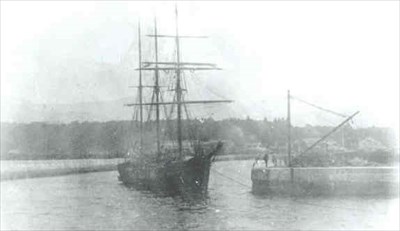Plaque reads
"This anchor is virtually all that remains of the schooner MARY B MITCHELL"
Free to view. Next to Tourist Information centre, harbour master's office and public toilets. Free car park close by.
The story of Mary B Mitchell.
A passage from "Some West-Country Coasters", a short pamphlet dedicated to T C Lethbridge’s observations from West-Country ports. It comprises of a collection of sketches drawn by Lethbridge in his own inimitable style. It is a very slim volume, comprised of only sixteen pages, every second one of being blank, therefore avoiding any show through that might spoil the viewing of each illustration, mentions
"the old "Mary B." is a British ship and a fine little vessel. She was built by Rogers at Carrickfergus in 1892, and is registered as being 227 tons. She was fitted out as the Q.8, and in June, 1917, she fought an action with a German submarine and reported that she had sunk her. But we must not remember that strange little action in the Bay of Biscay, nowadays." written in 1933
Source
She was used as a Q Ship during First Great War.
"Amongst the schooners used as Q-ships were two from Paul Rodgers' Carrickfergus shipyard, the Mary B. Mitchell and, possibly because she already had an engine, the Result."
Source
"The aim of a Q-ship was to lure a more powerfully armed enemy close enough to be itself destroyed. To aid the deception, only five men would appear on deck at any one time, to represent the usual crew compliment of a trading schooner. During an attack these men, the "panic party", would abandon their vessel, leaving the remaining crew to fight the ship when the enemy approached. Sometimes one of the men would dress in womens' clothing. This was not done because women were commonly seen on schooners, but originated from the theory that, to use Lieut. Muhlhauser's words, "the Hun was a boastful creature" and would therefore be encouraged to come closer than otherwise during the action. To further aid the deception, Q-23 was flying the flag of Holland, a neutral country, on her first patrol."
Source

"The 3-masted schooner 'Mary B. Mitchell' being towed out of the Inner Dock of Port Penrhyn, c.1900. Built in 1892 at Carrickfergus. She worked for the Anglesey Shipping Company until she was sold in 1919."
Listed in the 1915-16 edition of the Lloyd's Register as follows:
MARY B. MITCHELL
Official Number: 97575
Master: Captain D. Davies, appointed to the vessel in 1914
Rigging: steel, 3 masts, Schooner; 1 deck; 1 cemented bulkhead
Tonnage: 227 tons gross, 210 under deck and 195 net
Dimensions: 129.7 feet long, 24.4 foot beam and holds 10.8 feet deep; Quarter Deck 25 feet; Forecastle 10 feet
Construction: 1892, P. Rodgers & Co. in Carrickfergus
Owners: Right Honorable Baron Penrhyn (O.T. Jones, manager)
Port of registry: Beaumaris
Source
Q ship during First Great War
She was taken over by the Royal Navy 25 April 1916 to be converted into a 'Q' or decoy vessel. This meant that she was given concealed armament, and retained the outward appearance of being an innocent merchant vessel. At this time German submarines tended to approach their victims on the surface, remove the crews, then sink them by gunfire or scuttling charges. Attacking in this manner left them vulnerable.
When this occurred the decoy vessel would 'reveal' their armament and engage the submarine. The decoys changed their names frequently.
Mary B Mitchell was armed with 1 x 4 inch, 1 x 12 pounder and 2 x 6 pounder guns in concealed positions.
She carried a variety of false identities, which included - Amaris , Arius, Brine, Cancalais, Eider, Jeanette, Marie-Therese, Mary y Jose, Mitchell,
Neptune; her decoy ship number was 'Q.8'.
The speed of 'revealing' was shown in a report on the Mary Mitchell written in 1916.
"During trials, carried out at night, a broadside was fired 11 seconds after the 'bell for action' was pressed, hatches sliding off smoothly and guns swinging smartly into position ... This morning I inspected the vessel and found her to be a credit to her C.O." [quoted in 'Q Ships' by Carson Ritchie]
Q ships did have some success, but as the war went on U-boats tended to shoot first and ask questions later.
She was returned to civilian service in March 1919.
The MARY B MITCHELL was a well documented Q ship, a disguised merchantman with hidden guns used to sink surfaced U boats in WWI, she was designated Q9. She survived until 14/12/1944 when she ran aground in Kirkcudbright Bay.
Sources :
"Small Craft" by G.H.P. Muhlhauser (1920)
"Q-Ships and their Story" by E. Keble Chatterton Conway Maritime Press (1972)
The Ashburner Schooners ISBN 0-9516792-0-1
"Schooner Sunset" by Douglas Bennet Chatham Publishing 2001, ISBN 1 86176 17767